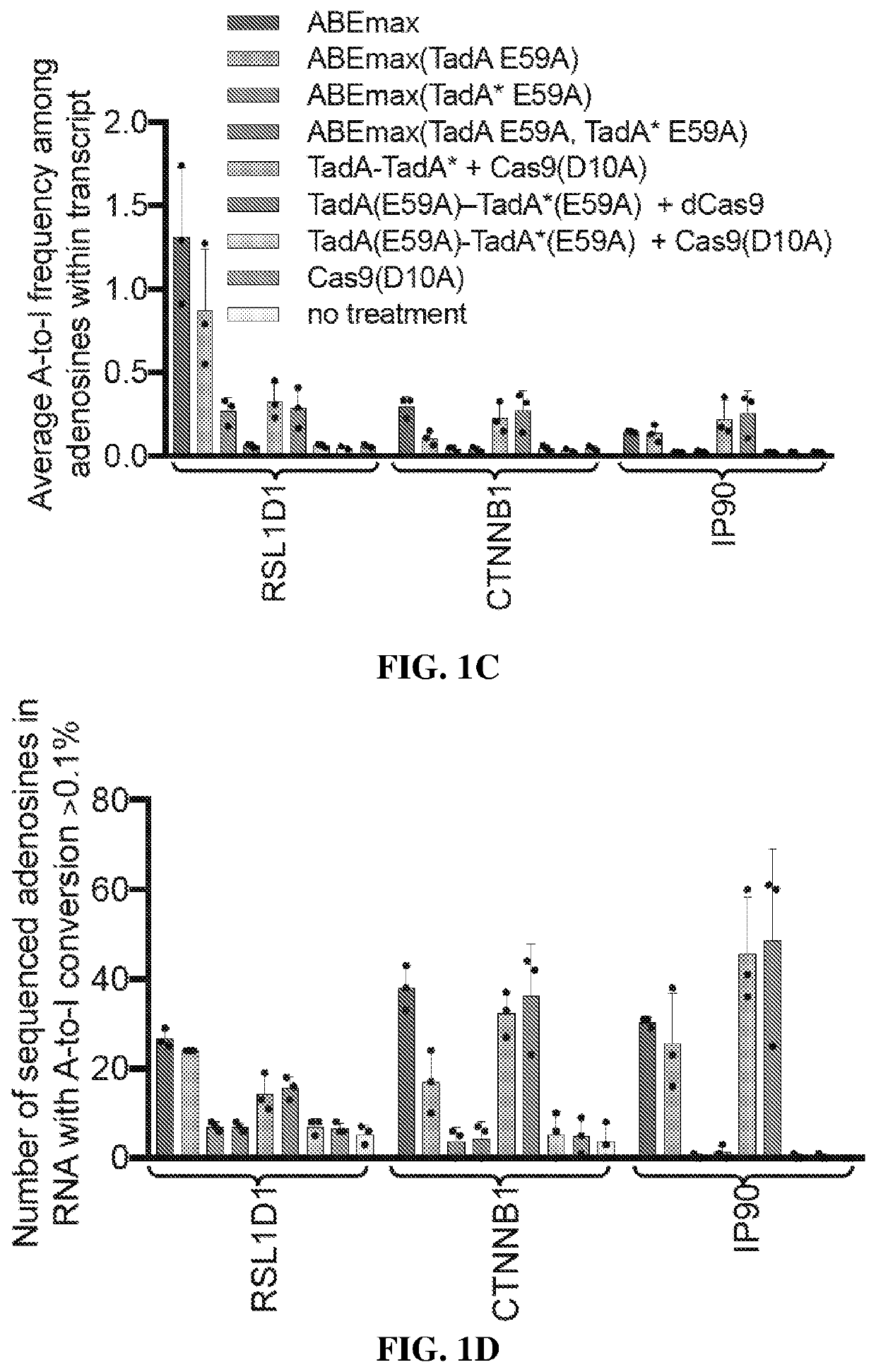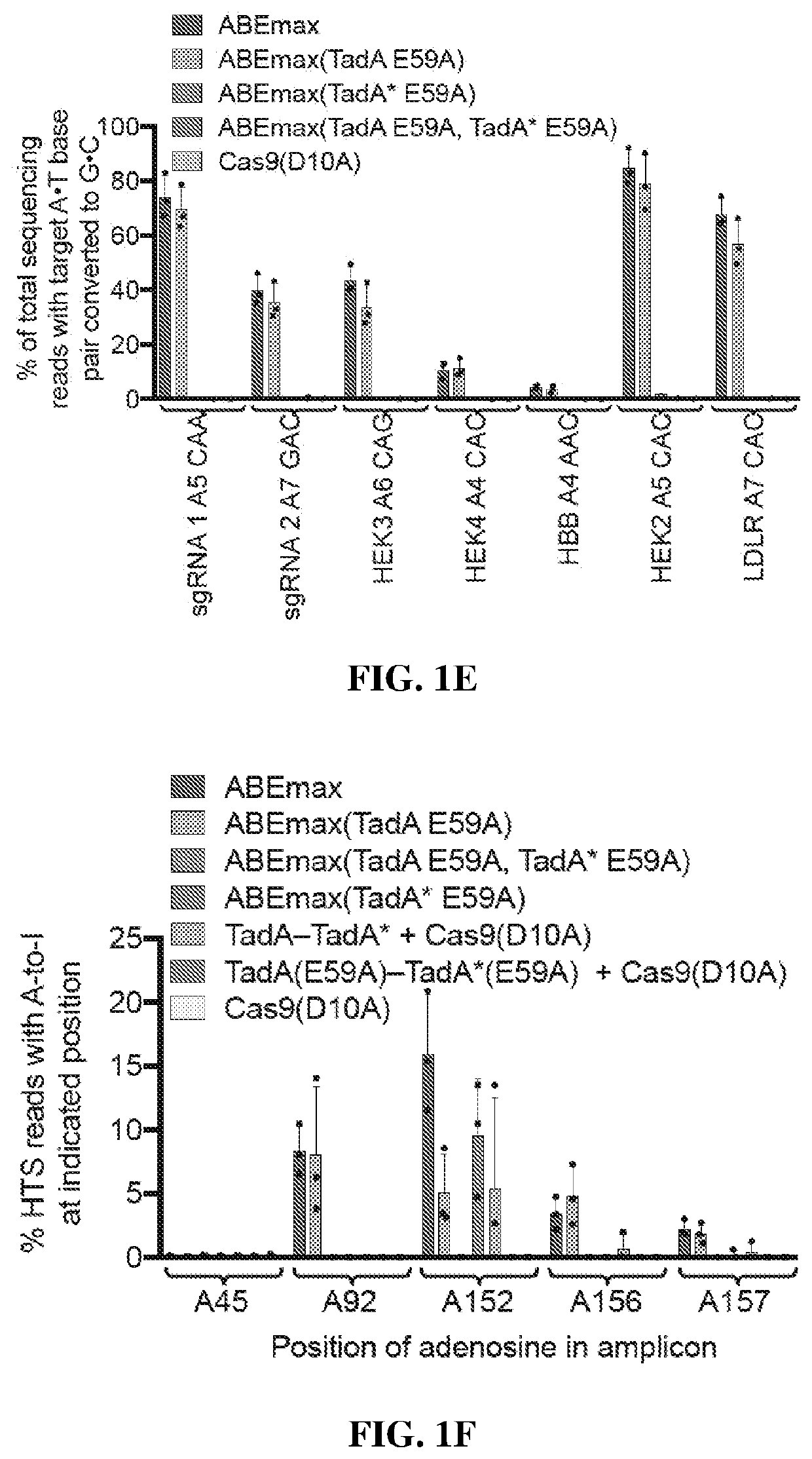Adenine base editors with reduced off-target effects
a technology of off-target effects and editors, applied in the field of adenine base editors with reduced off-target effects, can solve the problems of potential associated cytotoxicity and deleterious effects on the function of translated proteins
- Summary
- Abstract
- Description
- Claims
- Application Information
AI Technical Summary
Benefits of technology
Problems solved by technology
Method used
Image
Examples
example 1
[0389]HEK293T cells were transfected with a plasmid expressing ABEmax and isolating genomic DNA and RNA after 48 hours. After cDNA generation from poly-adenylated cellular mRNA, high-throughput sequencing (HTS) was performed on 220- to 250-nt regions of three mRNA amplicons: CTNNB1, IP90, and RSL1D1. CTNNB1 and IP90 were chosen as two examples of abundant mRNAs in HEK293T cells, and RSL1D1 was studied because it contains a region highly homologous to the 20-nt region of E. coli tRNAArg2 that is the native substrate of TadA(26). The TadA minimal substrate sequence is GCUCGGCUACGAACCGAG (SEQ ID NO: 1), while the homologous region of RSL1D1 mRNA is agUCGGCUACGGAAuuuAG (SEQ ID NO: 2), where upper-case letters indicate sequence identity. In all three transcripts, ABEmax generated low but detectable levels of RNA editing above the endogenous level of A-to-I editing from cellular deaminases(27, 29), which was measured using a Cas9(D10A)-only control. ABEmax expression increased both the ex...
example 2
[0396]Three TadA* residues were identified, predicted to interact with the RNA substrate as targets for substitutions that might impair TadA*-mediated RNA deamination. It was hypothesized that impeding the ability of TadA* to accommodate 2′-hydroxyl groups that are present in RNA, but absent in DNA, by replacing these three amino acids with larger or more hydrophobic residues (Gln, Phe, Trp, or Met) could further improve the DNA versus RNA editing specificity of ABEmax(TadA E59A). Arg 47 is predicted to form a hydrogen bond with the 2′-hydroxyl group of the substrate adenosine (FIG. 2A). Arg 47 was replaced in TadA* with Gln, Phe, Trp, or Met in an effort to abrogate this interaction. A series of ABEmax mutants was also generated with TadA* substitutions at either Asn 108 (FIG. 2B) or Val 106 (FIG. 2C), two residues that are located close to the catalytic site of TadA, and that mutated from Asp 108 and Ala 106 during the evolution of TadA*(1). Asp 108 is predicted to directly hydrog...
example 3
[0401]The applicability of the findings was tested to other mammalian cell types. First, the DNA base editing activities of ABEmax, ABEmax(TadA E59A), ABEmaxAW, and ABEmax(TadA E59A, TadA* N108W) in HeLa cells (FIGS. 5A-5B), and ABEmax and ABEmaxAW in U2OS and K562 cells (FIGS. 6A-6F) were compared. DNA base editing efficiencies among unsorted HeLa and U2OS cells were uniformly lower than in HEK293T cells (FIG. 5A), possibly due to poorer transfection or nucleofection efficiencies(15). The DNA base editing activity of ABEmaxAW relative to ABEmax and ABEmax(TadA E59A), however, generally remained similar in all three cell types (FIGS. 5A, 6A). Next, RNA editing frequencies and magnitudes were investigated in U2OS and K562 cells, and it was found that compared to ABEmax, the use of ABEmaxAW greatly reduced RNA editing to levels indistinguishable from those of the Cas9(D10A) control (FIGS. 6C and 6D). Together, these data indicate that ABEmaxAW can mitigate RNA editing in multiple mamm...
PUM
| Property | Measurement | Unit |
|---|---|---|
| Fraction | aaaaa | aaaaa |
| Fraction | aaaaa | aaaaa |
| Fraction | aaaaa | aaaaa |
Abstract
Description
Claims
Application Information
 Login to View More
Login to View More - R&D
- Intellectual Property
- Life Sciences
- Materials
- Tech Scout
- Unparalleled Data Quality
- Higher Quality Content
- 60% Fewer Hallucinations
Browse by: Latest US Patents, China's latest patents, Technical Efficacy Thesaurus, Application Domain, Technology Topic, Popular Technical Reports.
© 2025 PatSnap. All rights reserved.Legal|Privacy policy|Modern Slavery Act Transparency Statement|Sitemap|About US| Contact US: help@patsnap.com



